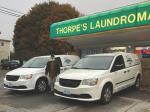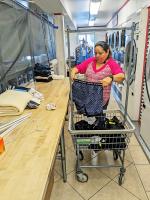CHICAGO — For those laundry owners willing to make the investment and travel beyond their store’s four walls, a residential pickup and delivery service expands their reach, boosts turns per day and increases revenue, but its success relies heavily on the laundry’s ability to pick up, clean and deliver the goods in line with each customer’s expectations.
That’s where taking the best paths becomes paramount. Calculating an efficient, cost-effective route is more than finding the shortest path between points, and there are some keys to improving on-time delivery and customer satisfaction.
TO POINT B AND BEYOND
“Pickup and delivery is an important part of our business, and having the proper point-of-sale system has been a key factor in deciding route effectiveness,” says Jan Barlow, whose Jan’s Professional Dry Cleaners in Clio, Michigan, includes an on-site laundromat. “Next up is database management and constantly updating notes to monitor customer concerns. And third is having well-trained drivers and vehicles that represent the image and branding.”
Todd Ofsink’s New York-based Todd Layne Cleaners & Laundromat offers WDF pickup and delivery service throughout Manhattan.
“We are always making adjustments to make the most effective use of our delivery routes,” he says. “We use a three-channel strategy. Local deliveries are done on foot within a short distance of our storefronts. We partner with a local courier service to accomplish deliveries that are further away and can be done more efficiently by car, electric bicycles and scooters. The third option is with DoorDash and Uber and customers are able to choose a short window in our delivery area.”
Can route optimization be as simple as implementing the latest delivery management software and letting it do its job?
“No, it cannot,” Ofsink asserts. “There are always logistical challenges, even with the latest software. There are last-minute cancellations, additional orders, vehicle mechanical issues, traffic/road closures and other issues that require employee intervention.”
“Not for us,” Barlow says. “We had to make a lot of route changes during COVID. The routing was not able to accomplish what we wanted easily. Optimizing sometimes has unforeseen consequences, like implementing all right turns or something equally as interesting.”
Brothers Aaron and Matt Simmons have a unique perspective of seeing the issue from the operations side within their family’s Super Suds Laundromat and Wash & Fold in Long Beach, California, and from the product development side within their Curbside Laundries laundromat management software company.
“It can be as simple as putting in the right software and clicking a button but drivers might have to deal with specified times for serving customers, so they might have to adjust it manually after the optimization,” says Aaron, noting that most laundries don’t have 100% commercial accounts, so the routes are a mix of residential and commercial orders.
“Once you get your list of stops and destinations, then the software is very good at optimizing that,” adds Matt. “You want to make sure you set your starting point and ending point. If you hit optimize but you don’t put in the end point, it might be an optimized route but you might end up at Timbuktu, very far away from the laundromat. You do want to run a nice loop.”
ROUTE INFLUENCES
Vehicle type, storage capacity and range of travel can influence routing choices. The Simmonses advise their clients to look at the next larger model vehicle they may need and to make their buying choice based on their service potential.
“As their route gets busier, they never anticipated filling the van, having to stop, turn around, head back to the laundromat, unload everything, get some more orders, load it back onto the van … and go back out,” says Aaron Simmons. “They all say the same thing: ‘If I had known my business was going to grow the way it is, I would’ve bought the bigger van to start off with.’”
“For us, vehicle type and storage capacity are important to understand,” Ofsink says. “Given that some customers have multiple large bags of laundry, this factors into how much can be picked up or delivered in one route. A courier service that we work with uses electric bicycles, some with trailers and some without. This deeply plays a role in the amount that can be transported in a route.”
“Because of our demographics, small transit vans don’t work for us,” Barlow says. “We tried it but we need a full-size van to accommodate what our routes are.”
Check back Thursday for the conclusion
Have a question or comment? E-mail our editor Bruce Beggs at [email protected].






















